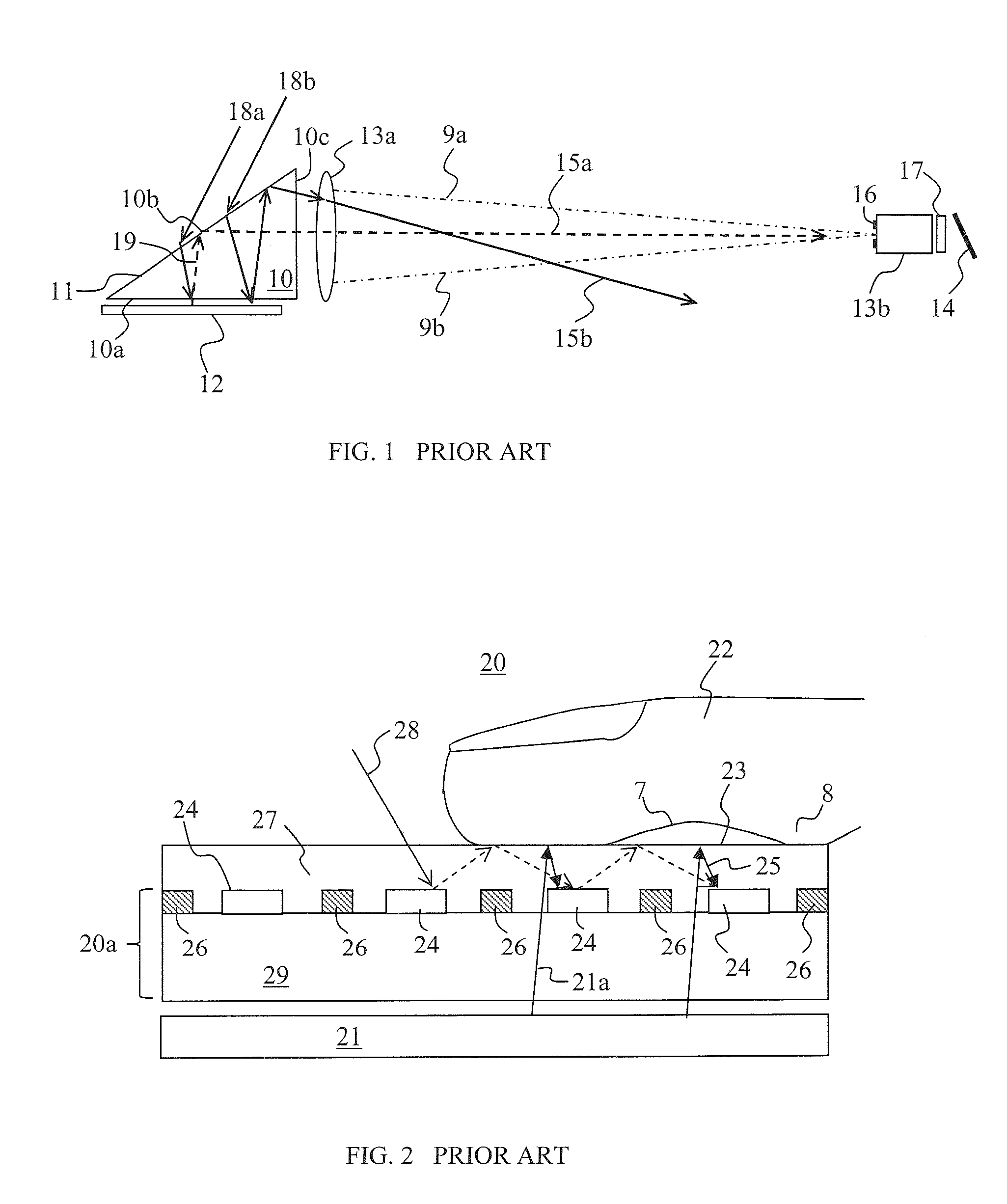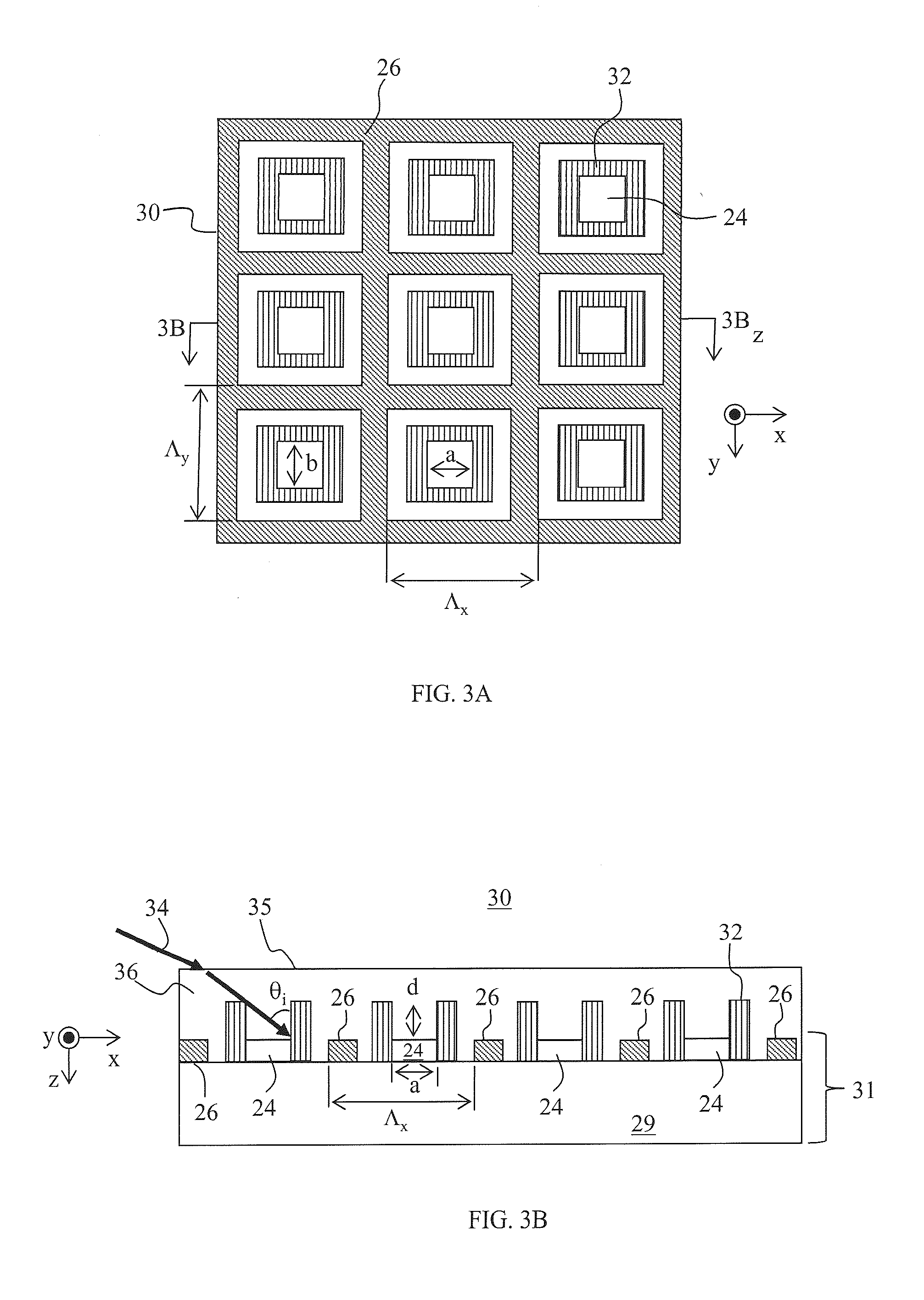Ambient light rejection for non-imaging contact sensors
a contact sensor and ambient light technology, applied in the field of non-imaging contact sensors, can solve the problems of fingerprint contact sensors that cannot be used in fingerprint scanners, fingerprint contact sensors that are saturated and lost, and commercially useful non-imaging contact fingerprint sensors that have not been successfully developed for use in fingerprint scanners, etc., to achieve the effect of reducing the effect of ambient ligh
- Summary
- Abstract
- Description
- Claims
- Application Information
AI Technical Summary
Benefits of technology
Problems solved by technology
Method used
Image
Examples
first embodiment
[0039]Referring to FIGS. 3A and 3B, a non-imaging contact sensor 30 in accordance with the present invention is shown having a two-dimensional array 31 of light sensing pixel elements (or pixels) 24 which is the same or similar as shown in array 20a as described earlier with the improvement of each light sensing pixel 24 having a light barrier (or wall) 32 surrounding its photosensitive region or area. Each light barrier 32 may be constructed of material(s) that are opaque to at least some of the wavelengths the light sensing pixel 24 is sensitive to and such light barrier 32 extends above the photosensitive region a distance “d” and barrier 32 helps restrict ambient light 34 from being detected by the light sensing region 24 of width “a” and height “b”. In such a manner, as illustrated in the x-z plane of FIG. 4B, light that propagates at an angle of θi is blocked from exposing the light sensing pixel 24. By way of example if the width of the light sensitive region 24 in the x dire...
second embodiment
[0045]However, in accordance with the present invention for fingerprint scanning applications, the reverse of the current trend for high fill factor is provided, namely that because of the possibility of the light sensing regions 24 being saturated by ambient light and because a TFT sensor for fingerprint scanning may be backlit (as opposed to digital X-ray applications where the sensor is always front lit), that the fill factor of the sensor array may be purposely reduced and in fact be in the region of <40%, or even <30% or <20% if needed to reduce the amount of ambient illumination received by the sensor array when such ambient illumination is present despite the loss of sensor array sensitivity. Thus, according to this embodiment, pixels with a fill factor (sensitive pixel area to total pixel area) smaller than 40% may be selected for manufacture of the sensor array.
third embodiment
[0046]Referring to FIG. 4, the present invention of a non-imaging contact sensor 37 is shown having two additional layers 38 and 39 on top of a protective layer 27, otherwise the sensor array 40 is the same or similar to sensor array 20a described earlier. A platen 44 in sensor 37 is provided by the surface of layer 39. Layer 38 provides one of a neutral density (ND) filter, a polarizing material, or a combination thereof. Although an ND filter will reduce both the ambient light 42 and the signal light 43, the purpose is to reduce the light level such that for a given integration time of the light sensitive pixels 24, the full-well depth of the detectors are not reached (in other words, the sensor pixels do not get saturated). Additionally there is a benefit of increased signal-to-noise-ratio (SNR) in that ambient light that “tunnels” underneath the finger as a result of multiple scattering / reflection events will traverse through a longer path length through layer 38 than the illumi...
PUM
 Login to View More
Login to View More Abstract
Description
Claims
Application Information
 Login to View More
Login to View More - R&D
- Intellectual Property
- Life Sciences
- Materials
- Tech Scout
- Unparalleled Data Quality
- Higher Quality Content
- 60% Fewer Hallucinations
Browse by: Latest US Patents, China's latest patents, Technical Efficacy Thesaurus, Application Domain, Technology Topic, Popular Technical Reports.
© 2025 PatSnap. All rights reserved.Legal|Privacy policy|Modern Slavery Act Transparency Statement|Sitemap|About US| Contact US: help@patsnap.com



